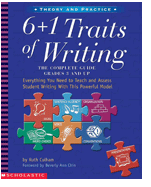Ruth Culham’s book 6 + 1 Traits of Writing is a tried and true method used to help students learn writing skills in grades 3 and up. Here, Lois Lee, a teacher in St. Charles, Illinois shares a lesson plan she created to help her students understand “voice, “ one of the 6 + 1 Traits.
Elementary teacher Lois Lee illustrates her elementary writing lesson plan to help students understand “voice.”
Purpose: Ask students to read a variety of familiar children’s authors, listening for traits that make their writing voice distinctive.
- In small groups, students will list traits that make these voices distinctive.
- The teacher will share an original story.
- Students list distinctive traits in the teacher’s voice.
- Students will practice imitating their favorite author’s voice, with their own story.
*Note: The teacher’s “voice” may also be included in this group of choices.
- Classmates share stories, trying to discover which author’s voice was imitated.
- Students will write a new story, using their own voice.
- Students will share their writing, (either whole class or small groups). Students should identify distinctive voices in their classmates’ writing.
Preparation: Gather a collection of favorite writing pieces and/or favorite authors.
Possible places to find “kid-friendly” articles:
- Highlights for Children, Scholastic, National Geographic for Kids’ newspapers
- Favorite authors include: Andrew Clements, Gordon Kormen, Gary Paulsen, Myra, Cohn Livingstone (poetry); Beverly Cleary, Lemony Snicket
- Write a short story of your own, so that students will hear YOUR voice in writing.
- Advise students to gather a collection of their favorite authors to share in class.
Lesson One:
- Define “voice” as written in Ruth Culham’s book, The 6+1 Traits, p. 102. Share some samples from that chapter.
- Discuss voice with students.
- Depending on your time frame, share a passage from a familiar author/book. Guide students in determiningcharacteristics of “voice” from this author.
- Some examples could be: a strong voice, with lots of energy;medium, so-so voice… some energy; a weak voicerunning out of energy.
Lesson Two:
- Over the course of a few days, read passages from books/magazines that you’ve collected and/or from student collections.
- Discuss traits of the voices heard, happy, sad, nervous, fearful, brave, adventurous
- On chart paper, write down the first words that students use for describing voice
Lesson Three:
- Student writing time (this can be spread over a few days as well)
- Give students time to write their own short story, IMITATING any one of the authors’ voices heard during the last few days. The story should be long enough, however, so the student’s imitated voice can be detected.
- Share stories as they’re completed. Allow students time to figure out which author the writer imitated.
- Alternative to whole class: Students can share stories in small groups, duringwriting workshop.
Lesson Four:
- Students write another original story, this time using their own voice. The teacher should collect the stories, and not reveal the author’s name
- Share stories in small groups or whole class. Can students determine the author from his/her voice?
Wrap up:
Ask students to respond :
- What advice would you give to another writer who wanted some help in strengthening his/her voice in a personal narrative?
- What is the greatest difference between your own writing voice and the voice you imitated?
- What is one important thing you learned about your voice?
Lois’ lesson plan helps her students understand “voice,” but this is only one of the 6 + 1 traits of a tried and true method used to help students learn writing skills in grades 3 and up. To learn about ways to help teach students learn writing skills, check out one of our literacy courses below:
Learners Edge is passionately committed to providing you with continuing education coursework, materials, and tools that will help you succeed in your classroom and in your career.
Offering more than 100 print-based or online courses for teachers, you can earn the graduate credit you need for salary advancement and meet your professional development needs. Contact us today to get started!







